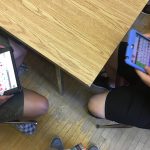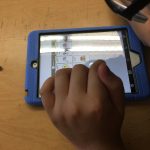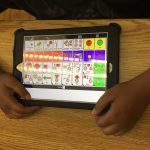Students within the autism spectrum disorder face a wide range of challenges which can often be tempered with tremendous strengths that allow them to interact in their world successfully. Their ability to communicate is one such challenge. The inability to communicate, in situations beyond the social world, can lead to distress, anxiety and frustration. Students with autism can be faced with this challenge every day and can often lead to behaviour resulting from these difficult emotions. Learning how to communicate effectively in the classroom is the purpose of this project. If we can teach students on the autism spectrum how to communicate their needs and feelings more effectively, especially at times when their emotional state is high, it can help to lessen a reaction because their needs are met.
A proven effective tool with this communication building is an iPad program called Proloquo2Go. It is a PEC-based system that teaches students key words for communication and allows them to string them together to form sentences, requests and questions. In our autism transition class, students will have an opportunity to receive one-to-one and small group direct instruction on the functionality of the program and how to effectively use it in their classrooms.
Team Members
Jayson Sy
Toronto District School Board
Sam Atwal
Toronto District School Board
Professional Learning Goals
- Learned how to use the iPad and Proloquo2Go software to increase vocabulary and facilitate communication
- Determined if typically non-verbal students with autism are able to use the iPad and Proloquo2Go software to communicate needs, make requests and ask questions, their physical and emotional needs would also be met
- Determined how increasing functional communication affects behaviour
- Determined that increasing a student’s ability to communicate helped decrease behaviour affected by distress, anxiety and frustration
Activities and Resources
- Introduce the students to the use of the iPad and to help facilitate navigation and ease of use
We decided to allow survey students on their prior use of iPads. Not surprisingly, many students have had prior experience with navigation, accessing apps, taking photos and going on the Internet. There was some time given for students to have “free reign” on the iPad where students could “show us their skills.” We treated it like a show and tell, where students got the spotlight to show off what they could do with the iPad.
- Have students explore the Proloquo2Go software with structured tasks meant to increase general competency
None of the students in the class had prior experience using the Proloquo2Go app. This was our ideal situation since it allowed all students to start with similar sets of skills. Separate lessons were developed that highlighted specific and targeted areas of the app. Most of these lessons were done using a demonstration style approach, but small groups and one-on-one were used as well depending on the nature of the task.
- Provide multiple opportunities for self-discovery and software exploration, as there are many ways in which students will learn to communicate and structure their sentences
Task cards were developed that had students work towards a goal. For example, a task card could ask the students to: “Ask a question about food” or “If you are thirsty, what can you say?”. For some periods, students were given short periods (approximately 10 minutes) to explore the app and play with the features. Luckily, the app’s interface made it easy to revert the screen back to their home screen without having to adjust the settings again.
- Allow students to work with peers to practise and role play using the iPad
This proved the most useful and also the most difficult task for the students to participate in. We quickly learned that providing the vocabulary to low verbal students does not necessarily mean that they will be able to communicate. Conversation structure seemed to be the biggest stumbling block from our assessment.
- Provide opportunities for students to teach peers how they use the program to collaborate and learn new techniques and strategies
This was one of our original activities suggested in our project proposal. Unfortunately, we were not able to achieve this stage. After working with the program for some months, we believe that it would take an additional year to even consider reaching a point where we could have students collaborate with each other.
Unexpected Challenges
One of the biggest unexpected challenges was the addition of a new student to the class. This student had great difficulty with the transition to our school and into our class. There was too much behavioural needs to contend with during this time that we had to take a pause on our project. The break lasted about three weeks and, at this point, we thought we had the student in a place where they could take part in the Proloquo2Go lessons. We did continue our project after this time, but the success realized in part 1 of this project was not mirrored in part 2.
Some other challenges we met during this project:
- Conversation structure and application needed to be taught in conjunction with vocabulary building. This proved to be beyond our scope of understanding language development and acquisition. However, we tried our best and still experienced great successes.
- It was difficult for some students to operate the iPad without being distracted by the other features of the iPad. We installed some parental controls on the iPads, but there wasn’t a program that addressed all of our classroom needs. Visual checks ended up working best.
- The Proloquo2Go app was initially easy to use at first glance. However, it has an immense amount of usability for a wide range of abilities and situations. Sifting through the options and settings was quite difficult. Further, pulling out the gems that we felt truly applied to our students and their abilities was even more difficult.
- Originally, we wanted the students to design their own homepage with vocabulary that was meaningful for their lives. However, after prep and planning, we decided to create a class home page with set vocabulary and folders. We then cloned the homescreen to display on all of the iPads. We think that this was the better choice!
Enhancing Student Learning and Development
By providing a platform where students with autism can increase their vocabulary and have support with communicating in the classroom, we can assure that their emotional, social and academic needs are being met. This will be accomplished through the use of technology, specifically an iPad and the software Proloquo2Go. Using these tools allows these students to access modes of communication that are atypical, but works to their abilities and strengths.
Being able to self-advocate, express needs, and communicate with peers and adults on a regular basis in a classroom setting are fundamental skills that all students need to lead a holistic school life. Further, these skills are necessary to function successfully in their lives when their schooling is complete. Not only will we be providing a means to learn these skills, but we will also be helping to mitigate the behavioural consequences of not being able to communicate. This will provide students with a more productive and richer learning experience.
Sharing
- The most important part of this project is to have students transfer what they’ve learned in our classes to the rest of their timetable. We will work with the other staff to train them with the program so they can provide assistance when necessary and also develop their own learning plan for communication that is more applicable to their subjects. We will also be sharing our findings with our school psychologist to determine if functional communication needs can be a criteria to apply for future SEA funding.
- Additionally, as the assistant curriculum leader of student support, I am in direct contact with many guidance counsellors and special education leads of the exceptional schools in the TDSB. I would like to share our success with our family of schools and encourage them to make use of STEM in their classrooms. Also sharing ideas and student experiences in a blog forum will enable us to network new ideas and reach educators beyond the Toronto District School Board.
- The results from this project will be highlighted at our school’s final PLC via PowerPoint. This will help teachers gain more insight as to how this project can inform their own teaching. We will be actively searching for additional team members for next year to continue this project. Also, we were able to be a demonstration classroom where teachers from different schools came in to see a demonstration of this project (this was in conjunction with another classroom doing a STEM-based project).
Project Evaluation
We had mixed feelings with reporting on the success of this project. I think we agreed that if our timeline was longer and we had another opportunity to build on and extend what we already accomplished, we could confidently say that our project was a success. For now, it is a working project and will be continued next year.
This is how we determined if our learning goals were met:
(1) Prior knowledge – Through observation and questioning, we will determine what the students know about the use of the iPad and whether or not they can navigate around the iPad. Another important piece is to determine what level of communication they are at so we can identify the student’s needs and challenges.
This worked out very well. The students were able to navigate the iPad before this project, so getting them familiar with Proloquo2Go was a bit easier in this case. Through observation and student/teacher conferences, we were confident that we could go ahead with the project and the tactile skills necessary to complete the activities would be no problem for the class.
(2) Communication skills – Students will be observed for current strengths and challenges with their communication. This is done through discussions with all classroom teachers and adult support workers. We will use this information to identify gaps and learning needs.
We sent surveys home to the parents and spoke to the other teachers that teach the autism class. We identified key areas for each student to focus our efforts on. Generally, our results were similar across the board. There is a demand for communication about daily living (i.e., eating, toileting, chores, safety, home tasks), expressing needs and wants, socializing both with adults/caregivers and peers, as well as problem-solving vocabulary in the context of social conflict and health.
3) Communication strategies – During student learning, a number of communication strategies will be taught via modelling, direct instruction and role-playing. We will be using checklists, rubrics and interviews to help progress their learning and identify additional challenges.
This occupied the bulk of this project. Creating situations where students attempt to form meaningful dialogue took a lot of time and planning. They students received a variety of teaching delivery models. The classroom lesson was actually the most successful when teaching a skill or a set of vocabulary. The students had some difficulty with role-playing activities. Those activities were not “real” enough for them and they had a hard time understanding how to use the vocabulary that we were focusing on in that particular context. Free play or self-exploration was met with some difficulties and some successes. As mentioned earlier, students with autism thrive in structured environments and tasks so, although we tried out best to keep it as independent as possible, the students worked better with a combination of structured tasks and self-exploration.
Measuring success with this project was very difficult. Although we had a good sense of the communication limitation of each student before the project, knowing where they are at after the project was hard to measure. Students were able to complete the task cards correctly approximately 80 per cent of the time by the end of the project. None of the students used the app independently outside of the structured time, although we encouraged the students to use it whenever they want to communicate. Parents reported some increase of new vocabulary, but couldn’t be more specific. We found that the use of the program did not have any impact on difficult social situations. However, we believe that with more exposure, their fluency with Proloquo2Go will improve and we may begin seeing them use this to facilitate communication in order to solve social skill difficulties and/or stressful situations.
Resources Used
Olive, M., Lang, R., & Davis, T. (2008). An analysis of the effects of functional communication and a voice output communication aid for a child with autism spectrum disorder. Research in Autism Spectrum Disorders, 2(2), 223‐236.
The purpose of this study was to examine the effects of functional communication training and a VOCA (Voice Output Communication Aid) on the challenging behavior and language development of a four-year-old girl with autism. The participant’s mother implemented modified functional analysis (FA) and intervention procedures at home. A multiple probe design across activities was used to analyze intervention effectiveness. Functional Communication Trainings with a VOCA (Voice Output Communication Aid) successfully decreased challenging behavior and increased VOCA use. A secondary analysis revealed increased pronoun use.
Casey, S.D., & Merical, C.L. (2006). The use of functional communication training without additional treatment procedures in an inclusive school setting. Behavioral Disorders, 32, 46‐54.
The premise behind functional communication training is to replace maladaptive behaviors with a communicative response that is either verbal or gestural. Such responses are the functional equivalent of the maladaptive or self‐injurious behavior except that they are more socially acceptable. In order for this to be successful, the communicative response must be reinforced heavily while the maladaptive or self‐injurious behavior is reinforced minimally, if at all. One 11-year-old student participated in this study. Results showed a decrease in maladaptive or self‐injurious behaviors.
Drager, K., Postal, V., Carrolus, L., Castellano, M., Gagliano, C., & Glynn, J. (2006). The effect of aided language modeling on symbol comprehension and production in two preschoolers with autism. American Journal of Speech Language Pathology, 15, 112‐126.
Two four-year-olds with autism participated in this study to determine the efficacy of Aided Language Modeling (ALM; Picture Communication Systems and natural language strategies) to improve receptive language symbol comprehension and production. Results indicated that ALM is an effective intervention to increase both symbol comprehension and production. The effects were maintained over the 37 sessions of the study.
Mancil, G.R., Conroy, M.A., Nakao, T., & Alter, P. (2006). Functional communication training in the natural environment: A pilot investigation with a young child with autism spectrum disorder. Education and Treatment of Children, 29, 615‐633.
This study examined functional communication training for one four-year-old boy over 60 sessions. Results demonstrated a reduction in maladaptive or disruptive behaviors, an increase in communication, and a reduction in response time to distracters.
Martin, C.A., Drasgow, E., Halle, J.W., & Brucker, J.M. (2005). Teaching a child with autism and severe language delays to reject: Direct and indirect effects of functional communication training. Educational Psychology, 25, 287‐304.
The study examined the effects of direct functional communication training, involving prompting, differential reinforcement, and error correction procedures, in teaching a 10-year-old child with autism to reject items by touching an icon. Results indicated that the training was successful at replacing pushing away with touching an icon to reject items, but it had variable effects on the other behaviors serving a rejecting function.
Polirstok, S.R., Dana, L., Buono, S., Mongelli, V., & Trubia, G. (2003). Improving functional communication skills in adolescents and young adults with severe autism using gentle teaching and positive approaches. Topics in Language Disorders, 23, 146‐153.
The study examined the therapeutic intervention program for young adults with severe autism at the Oasi Institute in Troina, Sicily. The program, which integrates gentle teaching, humanistic applied behavior analysis and functional communication training, values human interactions and provides opportunities to acquire functional skills through errorless learning activities. Eighteen adolescents with autism participated in the study. Results of an 18-month study indicated significant improvements in functional communication skills and an accompanying reduction in maladaptive/stereotypic behaviors in the environment using gentle teaching and positive approaches.
Braithwaite, K.L., & Richdale, A.L. (2000). Functional communication training to replace challenging behaviors across two behavioral outcomes. Behavioral Interventions, 15, 21‐36.
The study examined the effectiveness of an intervention that included extinction and functional communication training to reduce multiply controlled, self‐injurious and aggressive behaviors in a seven-year-old boy with autism in a school setting. Analysis of behavioral antecedents and consequences suggested that self‐injury and aggression served the dual behavioral outcomes of escape from difficult tasks and access to preferred objects. Treatment consisted of teaching the boy an alternate request, while challenging behaviors were concurrently placed on extinction. Acquisition of the alternate requests was associated with a decrease to zero levels of self‐injury and aggression across the two behavioral outcomes, which was maintained when a five‐second delay was implemented. Results showed that challenging behaviors with different behavioral outcomes can be replaced with functionally equivalent communication.
Resources Created
These resources will open in your browser in a new tab, or be downloaded to your computer.





